Your code for adding items to the list backing the ListView:
list.getItems().add("hi")
… seems correct. So you must have other problems. Unfortunately, you neglected to provide an MCVE, so we cannot diagnose.
As the Comments said, your layout seems suspect. ListView has its own scrolling, so no need to embed in a scroll pane.
Below is a basic example app. This app starts with a ListView with a single value of “bonjour” set in the initialize method of the controller. A button then adds your two items "hi" & "hello" to the list, one every click.
initialize method
The initialize method is part of the JavaFX lifecycle. On a controller class, first the constructor runs. Then the @FXML fields are populated via injection by the JavaFX framework. Lastly the initialize method is automatically called by the JavaFX framework. So within the initialize method we can modify/manipulate the already-instantiated JavaFX controls. In this example app we designate our ObservableList with a single item ("bonjour") to be the backing data of our ListView control.
You can annotate the initialize method with @FXML. Not necessary if the method is marked public. If marked private, the annotation is required. See documentation for @FXML.
Button-click method
The method assigned to react to each click of the button uses your code to retrieve the ObservableList we assigned during initialize, and add your "hi"/"hello" items to that list. Because the list is observable, the JavaFX framework automatically notices the change in our backing data model, and automatically updates the display of the ListView.
Example code
This code is using JavaFX/OpenJFX version 20.0.2, with Java 20.0.2, on macOS Ventura, modified from the JavaFX new-project template provided by IntelliJ 2023.2.1.
A screenshot after having clicked the button three times.

The FXML file:
<?xml version="1.0" encoding="UTF-8"?>
<?import javafx.geometry.Insets?>
<?import javafx.scene.control.Label?>
<?import javafx.scene.layout.VBox?>
<?import javafx.scene.control.Button?>
<?import javafx.scene.control.ListView?>
<VBox alignment="CENTER"
spacing="20.0"
xmlns:fx="http://javafx.com/fxml"
fx:controller="work.basil.example.fxlistview.HelloController">
<padding>
<Insets bottom="20.0"
left="20.0"
right="20.0"
top="20.0"/>
</padding>
<Label fx:id="welcomeText"/>
<Button text="Add two more items to list"
onAction="#onClickOfAddButton"/>
<ListView fx:id="exampleListView"/>
</VBox>
The controller:
package work.basil.example.fxlistview;
import javafx.collections.FXCollections;
import javafx.collections.ObservableList;
import javafx.fxml.FXML;
import javafx.scene.control.Label;
import javafx.scene.control.ListView;
public class HelloController
{
@FXML
private Label welcomeText;
@FXML
private ListView < String > exampleListView;
@FXML
protected void onClickOfAddButton ( )
{
this.addToList ( );
}
private final ObservableList < String > observableList = FXCollections.observableArrayList ( "bonjour" );
public void addToList ( )
{
exampleListView.getItems ( ).add ( "hi" );
exampleListView.getItems ( ).add ( "hello" );
}
@FXML
private void initialize ( )
{
this.exampleListView.setItems ( this.observableList );
}
}
The Application subclass:
package work.basil.example.fxlistview;
import javafx.application.Application;
import javafx.fxml.FXMLLoader;
import javafx.scene.Scene;
import javafx.stage.Stage;
import java.io.IOException;
public class HelloApplication extends Application
{
@Override
public void start ( Stage stage ) throws IOException
{
FXMLLoader fxmlLoader = new FXMLLoader ( HelloApplication.class.getResource ( "hello-view.fxml" ) );
Scene scene = new Scene ( fxmlLoader.load ( ) , 320 , 600 );
stage.setTitle ( "Hello!" );
stage.setScene ( scene );
stage.show ( );
}
public static void main ( String[] args )
{
launch ( );
}
}
These Questions helped me here:
